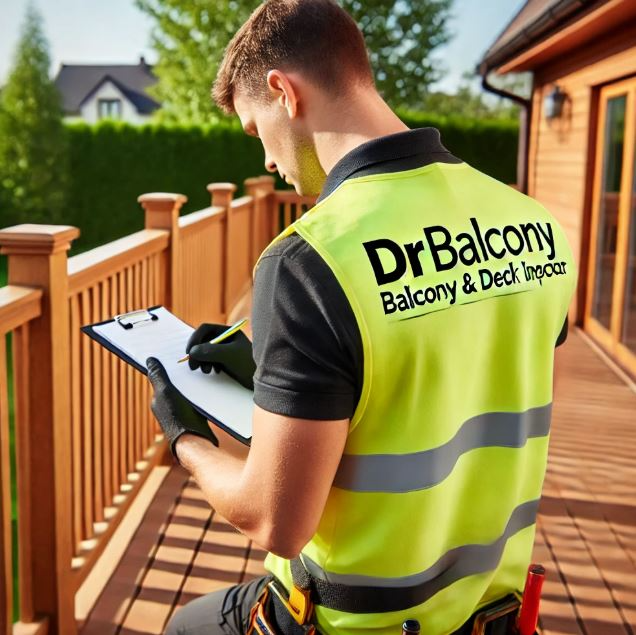Balconies and decks are beloved extensions of our homes—spaces for relaxation, entertaining, and enjoying the outdoors. But like any part of your property, they require regular care to stay safe and functional. Over time, weather, wear and tear, and structural stress can compromise their integrity, leading to hidden dangers. Skipping inspections might save time or money in the short term, but the long-term risks far outweigh those savings. In this article, we’ll explore why professional inspections are a smart investment for homeowners, protecting your family, finances, and property value.
1. Prevent Costly Repairs (and Catastrophic Failures)
Small issues left unchecked can snowball into expensive disasters.
- Early Detection Saves Money: Cracks, rot, or loose fasteners are easier and cheaper to fix when caught early. For example, replacing a corroded bolt costs far less than rebuilding a collapsed railing.
- Avoid Structural Collapse: Decks and balconies bear heavy loads. A weakened support beam or rotting joist can lead to sudden failure, endangering lives and requiring total reconstruction. Regular balcony inspections ensure structural integrity and compliance with safety regulations.
- Water Damage Mitigation: Inspections identify leaks, poor drainage, or damaged waterproofing membranes. Left unresolved, moisture can rot wood, corrode metal, and destabilize foundations.
Real-World Example: In 2015, a California balcony collapse injured six people due to dry rot that went undetected for years. The incident led to millions in legal settlements and stricter state inspection laws.
2. Ensure Safety for Family and Guests
Your balcony or deck is only as safe as its weakest link.
- Railings and Guardrails: Loose balusters, rusted brackets, or inadequate height can lead to falls, especially for children. Inspections verify compliance with safety codes (e.g., 4-inch baluster spacing).
Slip Hazards: Mold, algae, or worn surfaces increase slip risks. Professionals assess traction and recommend non-slip coatings or repairs during a deck inspection.
Weight Capacity: Overloading with furniture, planters, or hot tubs can strain supports. Inspectors evaluate load limits and flag unsafe practices.
Stat Alert: The CDC reports over 224,000 deck-related injuries annually in the U.S., many preventable with proper maintenance.
3. Protect Your Home’s Value and Curb Appeal
A well-maintained outdoor space boosts resale value—but neglect can tank it.
- Buyer Confidence: Home inspectors scrutinize decks and balconies during sales. Issues like rot, code violations, or unstable footings can derail transactions or force price reductions.
Aesthetic Longevity: Faded finishes, splintered wood, or rust stains detract from your home’s appeal. Inspections identify cosmetic fixes to keep your space looking pristine.
Insurance Premiums: Some insurers offer discounts for homes with documented maintenance, including structural inspections.
4. Comply with Insurance and Legal Requirements
Inspections aren’t just wise—they’re often mandatory.
- Insurance Claims: After storms or accidents, insurers may deny coverage if damage resulted from pre-existing neglect. Regular inspections provide proof of due diligence.
Local Building Codes: Many municipalities require periodic inspections for elevated structures, especially in disaster-prone areas. Fines for non-compliance can be steep.
Liability Protection: If a guest is injured on your property, inspection records demonstrate you prioritized safety, reducing legal liability.
5. Extend the Lifespan of Your Investment
Balconies and decks are significant financial investments. Inspections help them last decades, not years.
Material-Specific Care:
- Wood: Inspectors check for rot, insect damage, and proper sealing.
Composite: Look for warping, mold growth, or fading.
- Metal: Assess corrosion, weld integrity, and coating wear.
- Climate Adaptations: Harsh winters, coastal salt air, or intense sun demand tailored maintenance. Inspectors recommend region-specific solutions.
Pro Tip: Coatings, sealants, and reinforcements recommended during inspections can add 10–15 years to your structure’s lifespan.
6. What Does a Professional Inspection Cover?
A thorough inspection includes:
1. Structural Components:
- Footings, posts, and beams for stability.
- Joist hangers, ledger boards, and connections to the house.
2. Surface and Railings:
- Flooring cracks, splinters, or rot.
- Railing strength, height, and spacing.
3. Water Management:
- Drainage systems, flashing, and waterproofing.
4. Code Compliance:
- Adherence to local safety standards.
Inspectors provide detailed reports with photos, repair priorities, and cost estimates.

When to Schedule an Inspection
- Annually: Ideal for older structures or harsh climates.
After Severe Weather: Storms, earthquakes, or heavy snow can shift supports.
Before Major Events: Hosting a party? Ensure your deck can handle the crowd.
During Home Sales/Purchases: Protect your investment and negotiate confidently.
The Hidden Cost of Skipping Inspections
- Emergency Repairs: Crisis fixes cost 3–5x more than planned maintenance.
- Medical Bills: Injuries from collapses or falls can lead to lifelong expenses.
- Decreased Property Value: Buyers often deduct repair costs from offers—plus, you lose bargaining power.
Conclusion: An Ounce of Prevention Is Worth a Pound of Cure
Balcony and deck inspections are a small upfront cost with massive long-term rewards. They safeguard your loved ones, preserve your home’s value, and prevent financial headaches. Whether your structure is new or decades old, a professional inspection provides peace of mind—and pays for itself many times over. Don’t wait for visible damage to act. Schedule an inspection today, and enjoy your outdoor space with confidence, knowing it’s built to last.